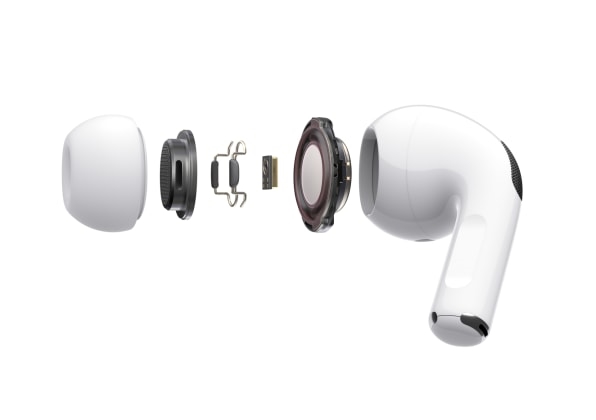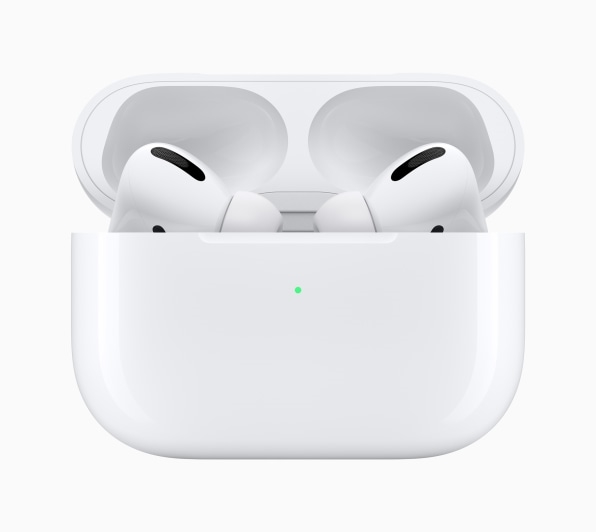Apple’s new AirPods Pro earphones are worth the $250 price for their impressive noise cancellation and audio quality, but those features are only great if the earphones will fit snugly in your ear canals.
While the older AirPods fit loosely inside the ears (and cost $90 less), these new ones have flexible tips that form a seal at the ear canal and take control of what sound gets into the eardrum.
For me, that automatically sets a high bar for the AirPods Pro. I don’t really like having something blocking my ear canal. But I’ll put up with it I’m rewarded with great sounding audio and sweet silence in the midst of a noisy world. With Apple’s latest wireless earbuds, I was. Just as important, they pack multiple clever ideas that are classic Apple—taking a good product and refining it into something even more useful and engaging.
Block that noise
The AirPods Pro have to block the ear canal to enable their biggest new feature–active noise cancellation. The technology has become common in larger, over-the-ear headphones like Bose’s QuietComfort line, but putting that kind of audio processing power into a wireless earbud design is a real engineering challenge.
Noise cancellation carefully analyses the sound of the outside world, then cancels it out by emitting a sound with an equal and opposite frequency profile. But to do this, the outside sound and its opposite have to be kept separate; that’s why the AirPods Pro seal off the eardrum from the world. The seal at the ear without the negative audio processing is just passive noise cancellation. A tiny microphone is pointed at your eardrum, and based on what your ear is hearing, the earphones’ H1 processor is constantly adjusting the noise cancellation to accurately negate the ambient noise.
It works. While I was sitting in a Starbucks working, the AirPods Pro blocked out a lot of background chatter, and the general ambient sound of a busy coffee shop went away. When I listened to music while driving, however, the noise cancellation didn’t do much to block the lower-frequency sound of the car and the tires moving over the road. But it’s not the lower frequencies that distract–it’s the higher-pitched sounds like human voices.
The AirPods Pro offer three settings for noise cancellation: fully on, completely off, and a “transparency mode” that uses the microphones in the device to pipe the noise of the outside world into your ears. Some reviewers complained that you can’t control the exact balance between noise cancellation and transparency, but for me, that’s overkill.

Apple does some compelling things in this product to make you feel better about having your ear canals sealed off.
The silicon buds are some of the softest and most bearable I’ve worn. Some in-ears I’ve worn seem trapped inside my ear, or create an uncomfortable vacuum effect within the ear canal. These do not. In fact it’s not hard to forget they’re in there. Apple’s engineers created a new way for the silicon pieces to attach to the earphones; they snap in neatly and stay that way.
Previous AirPods let you control features by tapping the post-like end of the bud that pokes out of your ear. Apple has done something far more sensible in the new AirPods. It’s not a button but rather a pressure sensor situated underneath a little oblong indention in the plastic on the side of the post. You use this to play or pause or skip songs and to choose between the noise cancellation modes. It senses the pressure from your finger and gives you a small bleep of audio feedback when you press on it. And you can customize both the left and right AirPods’ functions—if, for instance, you want pressing one of them to summon Siri.
Another major improvement is the way the AirPods Pro connect via Bluetooth with other devices. I always had trouble getting my first generation AirPods to connect, and stay connected, with the phone after I put them in my ears. These new buds connect and stay connected. If I suddenly play something on my Apple Watch, the AirPods immediately begin monitoring that source. It all feels logical and automatic and way more reliable.
One issue still annoys me. When my phone rings and the AirPods are anywhere nearby out of their case, the phone will redirect audio to the AirPods even if they’re not in my ears. That’s frustrating, especially when I’m on the go and the AirPods are in my pocket.
A new feature in iOS 13.2 lets two pairs of AirPods monitor the same source. So you and a friend can watch a movie or listen to a podcast together. Something so basic and fun is way past due, so I’m glad iOS supports it now.
The AirPods Pro case is considerably larger than that of earlier AirPods. But it does come with wireless charging—an extra-cost option for standard AirPods—as a standard feature.

The music question
For spoken word stuff like podcasts, some level of passive noise cancellation is good enough–if I can hear the words clearly, I’m happy; I don’t need to catch the nuance of every contralto and vocal fry. But if I’m to jam an earphone into my ear canals, the music better sound amazing.
Did the AirPods Pro meet that mark? Yes, with a caveat.
Whether the AirPods Pro give you great audio quality depends entirely on how well they fit into your ear canals. The silicon tips must form a seal at the opening of the canal or the whole audio experience falls apart. Apple knows this. That’s why it includes three different sizes of silicone tips in the box and why they’ve added a new feature called the “Ear Tip Fit Test” in iOS to help you pick the right size for you. It plays some audio over the AirPods Pro, then uses their microphones to detect any leakage.
When I first tried the AirPods Pro, I was disappointed in the audio. It lacked the wide frequency range, clarity, definition, and spaciousness I’ve heard in other earbuds. So I went back to the fit test thing, tried the other small and large ear tips, and spent some time moving the earpieces around in my ear and until the test said I had a good seal.
Once I’d done all that, the sound improved considerably. That little microphone that’s always listening to what your ear is hearing serves another important purpose, Apple told me; it helps the AirPods’ H1 processor continually tune the EQ of the music to the unique shape of your ear.
I’m still having a bit of trouble getting the earpieces to maintain their seal when I’m walking, but I can live with that. The shape of my inner ear may be odd. Three colleagues told me they passed the AirPods fit test with no problem. They all said the medium-size tip worked for them, although one found success with the small tip for one of his ears.
My advice: If you’re going to lay down $250 for a pair of AirPods Pro, ask to try on a pair in the store and make sure that one of the tip sizes fits your ears correctly.
In just two years of existence, AirPods have become remarkably ubiquitous. But there are places where I notice more over-ear noise cancellation headphones–mainly Bose’s QuietComfort line and subsequent models. Those places are within the habitat of the Digital Nomad, the worker who spends a lot of time away from the office in a shared workspace, a coffee shop, or an airport lounge. They’re places where the ambient noise is considerable, making noise-cancelling headphones a must. Bose has dominated that market segment with its QuietComfort line and other more recent over-ear offerings.
The digital nomad market and beyond
Personally, I’ve been in the habit of wearing my first generation AirPods while I’m walking or biking to the coffee shop or workspace, but after I get there, I switch to my bulkier Bose QuietComfort 35s because I need to shut out the ambient noise while I’m working. Now that AirPods have added active noise cancellation, I might be tempted to leave the Bose headphones in my bag. I wonder how many of my fellow digital nomads will make that same decision.
There may be something bigger going on here, too. When you need to hear the outside world, what you hear—in transparency mode—is the sound being captured by the AirPods Pro’s tiny microphone, pumped into your ears by the tiny driver.
Creative Strategies analyst Ben Bajarin thinks that this technology has implications for Apple’s future. “The more I play with AirPods Pro, the more I am convinced Apple is moving toward computational audio experiences, including better hearing,” he says. In the future, transparency mode could expand to amplifying specific aspects of the outside world–perhaps based on the frequency or direction of the sound–and the user might be able to adjust this using an app or Siri command.
It’s not a new idea (An ill-fated startup called Doppler’s did something similar with its Hear One buds.) Other earbud makers have been flirting with the idea of offering hearing aid-like features in their products for several years now (see Bose’s $500 Hearphones). Apple may have the miniaturization and design chop to pull it off and the brand name to popularize it. Hearing aids, by the way, are a $7.2 billion market.
The first generation AirPods were announced three years ago alongside the new iPhone 7, and I remember thinking the new earphones stole the show. AirPods were a surprising and refreshing addition to Apple’s portfolio.
The AirPods Pro represent the first major variation on the AirPod theme. They’re a fairly radical departure from the second generation AirPods, drastically changing the design, adding major new features like noise cancellation, and introducing the silicon tips. This is no humdrum yearly upgrade cycle. AirPod Pro seems like the product of rapid iteration and invention and people having fun doing it. That’s in sharp contrast to the slower and more predictable evolutions of other Apple products, including iPhones. It’ll be fun to see where Apple takes the AirPods next.
(53)